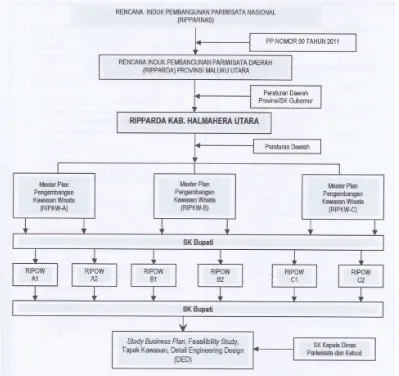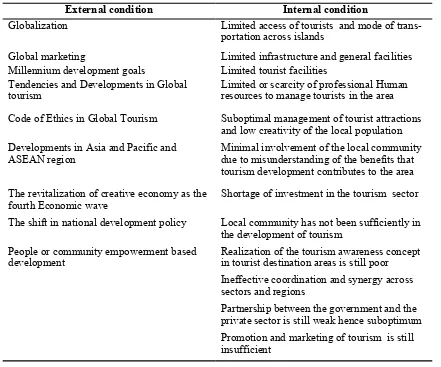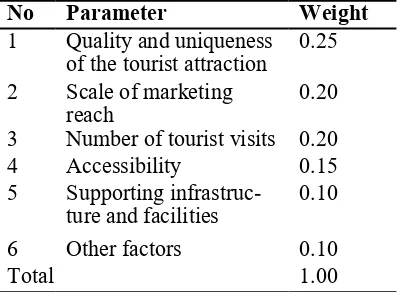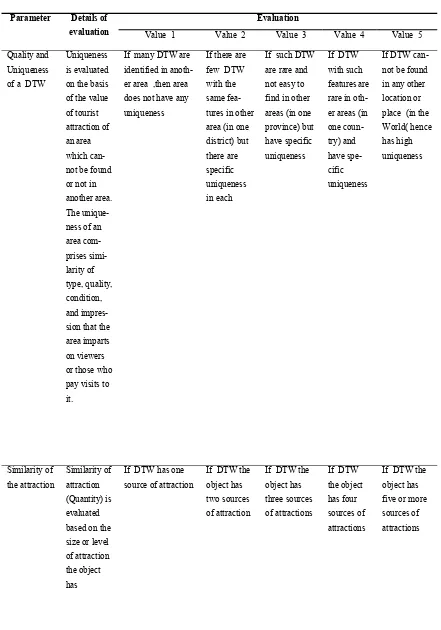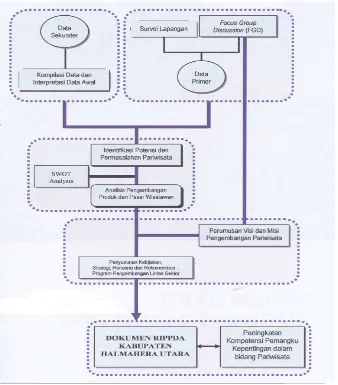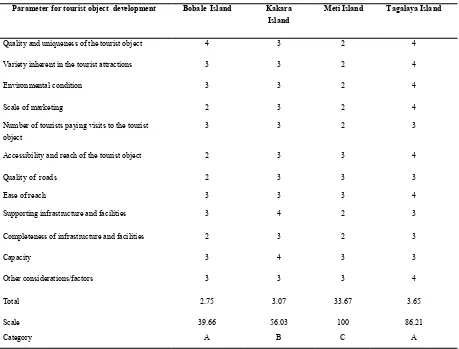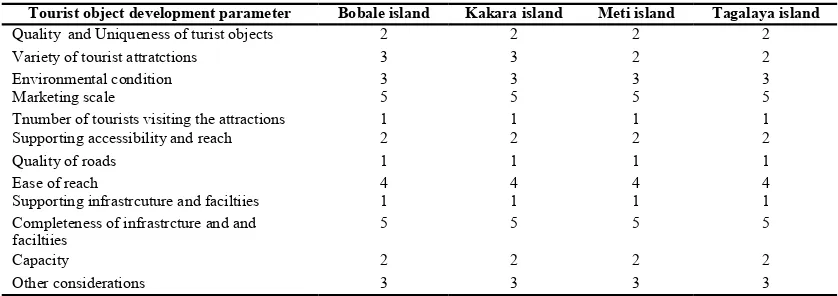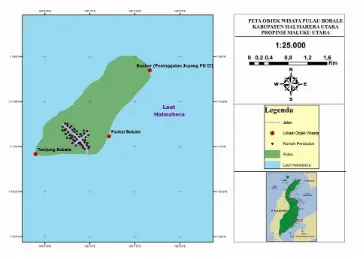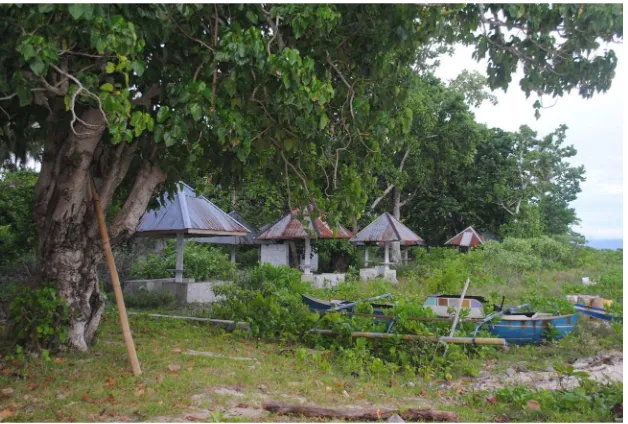Copyright © 2017, JKAP, ISSN 08529213 (Print), ISSN 24774693 (Online)
JKAP (Jurnal Kebijakan dan Administrasi Publik) Vol.21 (1), May 2017, 82-106
ISSN 0852-9213 (Print), ISSN 2477-4693 (Online)
Available Online at https://journal.ugm.ac.id/jkap
Evaluation of the Implementation of Tourism Policy
Yerik Afrianto Singgalen Politeknik Perdamaian Halmahera
singgalen.yerik@gmail.com Pamerdi Giri Wiloso
Universitas Kristen Satya Wacana pamerdi.giri@staff.uksw.edu
Gatot Sasongko
Universitas Kristen Satya Wacana gatot.sasongko@staff.uksw.edu
Abstract
This purpose of the study is to evaluate the implementation of tourism programs in Bobale Is-land, Kakara IsIs-land, Tagalaya Island and Meti Island in North Halmahera District. The study is based on a model developed by George Edward III, and used qualitative methods to collect and analyze data. Data collection techniques used included in-depth interviews, observation
and study of the documents. Results of the study showed that resources, communication, dispo-sition and bureaucratic structure are the main factors that influence the implementation of tour-ism policies are. Nonetheless, this study also showed that public support through public partici-pation in the implementation process is also an important factor that determines the success of tourism policy. To that end, community support or community participation should be an im-portant factor that must be taken into account in the formulation of development priorities of Tourism development Master plan for North Halmahera District government.
INTRODUCTION
Research on tourism policy begun in 1990s. This is evidenced by a 1996 research by Kadar on the implementation of tourism development policy in Aceh province. By the same token, Habbibuw (1997) conducted research on the implementation of tourism development policy in Mojokerto district. Toward the late 1990s, 1999 to be exact, Pakpahan conducted a study on the imple-mentation of tourism institutional develop-ment policy on the tourism office of Yogya-karta city government. Some of the key issue that were the focus of the previous studies on tourism development policies in various areas included funding sources and re-sources, communication, disposition of pro-gram implementers in influencing the per-formance of the program. Results under-scored the importance of the four factors in the success or lack of it, of tourism develop-ment programs.
Research on tourism policy during 2000s continued to focus on the same factors that were also central for research in 1990s. This is reflected in the focus of the research that continued to be the influence of funding and other resources, communication, dispo-sition of policy implementers and the bu-reaucracy on the performance of tourism de-velopment programs. A study by Huttapea (2001) on the implementation of tourism ac-tivities in Jayapura city is a good example of such research. Besides, other researchers embarked on research that evaluated the per-formance of tourism planning based on an input-output model. Such a research was conducted by Basri (2002). Basri’s study investigated the performance of the imple-mentation of RIPPDA, West Kalimantan province, while another study by Dewi (2005) on the effectiveness of implementing tourism development policy in Palembang was another one.
As regards tourism policy, some re-searchers investigated tourism policy out-comes and benefits. A study by Rettob (2008) on the implementation of RIPPDA in Papua province, another one by Agistiani (2014) on the implementation of poverty re-duction policy in Brayut tourism village. Ob-servation of previous research on tourism
policy leads to the conclusion that economic aspect of the sector has attracted the most research attention. Some researchers who have conducted studies on the economic de-velopment of tourism include (Brida & Ris-so, 2010; Hall, 2009; Haydock, 2014; Yang & Chen, 2009), while other researchers car-ried out studies on the relationship between tourism economic development and tourism products and services, in this case tourist attractions (Getz & Page, 2005; O’Sulli-vana, Pickernella, & Senyardb, 2009; Preuss, 2009; Robertson, Rogers, & Leask, 2009). Nonetheless, not all previous research on tourism policy focused on tourism economic policy. Some researchers investigated the policy that regulates the collaboration among stakeholders in tourism sector (Theodoraki, 2009; Wesley & Pforr, 2010; Yaghmour & Scott, 2009). This is an indication that the focus of research on tourism economic poli-cy is increasingly being tailored toward the economic aspects.
In addition to economic aspects, some research on tourism policy investigates so-cial aspects. Some of the researchers who have focused on social aspects of tourism policy such as (Curry & Brown, 2010; Doherty, 2009; Nunkoo & Ramkissoon, 2010; Roberts, 2010; Saayman, Van der Merwe, Saayman, & Mouton, 2009). In fact some researchers investigated the sustaina-bility of tourism development (Dredge & Whitford, 2011; Hall, 2011) , and others have looked into community based tourism (Wray, 2011). To that end, it is apparent that developments in research on tourism policy have delved into economic, and social as-pects of society who live in the vicinity of tourist attractions.
In a study on tourism policy, Veriani (2009) used Edward III model to identify factors that influence successful implemen-tation. Veriani (2009) found that determi-nants of successful implementation of tour-ism policy include, resources, attitude and disposition of implementers of the policy and the bureaucratic system that implements the policy. In the same vein, a research by Fianda (2008) found that resources, commu-nication, attitude and disposition of imple-menters of the policy and bureaucracy sys-tem are key determinants of success of
84 Copyright © 2017, JKAP, ISSN 08529213 (Print), ISSN 24774693 (Online)
cy performance. Based on the foregoing, it is apparent that research results showed that financial resources, and other resources as well as human resources influence the im-plementation of the policy. In addition, atti-tude and disposition of implementers of ac-tivities are also key factors that influence the performance of the tourism policy.
Issues that most previous research on the implementation of tourism development policy, have largely focused on aspects of the government bureaucracy (resources, communication, disposition of implementers of the policy and the bureaucracy system). In light of that, the objective of this research is to evaluate the implementation of tourism policy in Bobale, Meti, Tagalaya and Ka-kara islands inn North Halmahera district. The research not only evaluates aspects that relate to the bureaucracy as listed above, but also for get a more comprehensive and com-plete picture of the determinants of the poli-cy, assesses the impact that community sup-port as gauged from public participation, on the development of tourism in the district.
RESEARCH METHODS
This research used descriptive methods that is underpinned by a case study approach based on Edward III analysis model. The research assessed resources, communication, attitude and disposition of implementers of tourism policy and the bureaucracy system that is responsible for implementing the poli-cy.
The researchers base their arguments on Creswell (2009) who posits that qualita-tive research starts with assumptions that form and influence study of the problem that is researched which is also relates to the meaning individuals or group of individuals attach to the problem. To study the problem, qualitative researchers use the latest qualita-tive approach in conducting the research, collecting data using techniques that take into account sensitivity of the society toward the issue that is researched, conduct analysis of inductive and deductive data, and identify various patterns and themes that emerge. A report of the findings must encompass vari-ous voices of participants, reflections of the
researchers, descriptions and interpretation of the problem that is investigated and iden-tify and describe the contribution the re-search makes to literature and make recom-mendations for change.
This research started with a results of the documentary study that showed that the implementation of tourism development pro-gram in North Halmahera was not entirely satisfactory, hence performance was far from expectations as indicated in the district tourism development Master plan (RIPPDA) for North Halmahera, 2011 -2015. During the research process, the re-searchers conducted observations of several tourist attractions that are placed on the pri-ority list in the development of infrastruc-ture and facilities to support tourist objects in Kakara, Meti, Tagalaya and Bobale is-lands. Results of the observations showed that infrastructure and facilities to support tourism in in some tourist attractions has not been built as yet. The implication that the implementation of tourism development pol-icy on the ground is not in line with district government expectations and goals that are stated in RIPPDA. What is more disconcert-ing though, is that even where infrastructure and facilities has been development, mainte-nance has not been done which has led to damage and dereliction.
In an endeavor to identify problems that have hampered the implementation of tourism development program in the district, the research team conducted an in-depth in-terview of members of the public who live in the vicinity of tourist attractions, village heads and district tourism and culture office head, North Halmahera district (Theo Sosebeko, in 2015 and Joice Betsy Mahura, in 2016). Outcome of the interview of the informants were transcribed and subsequent-ly clarified in line with themes that formed a matrix. Researchers used triangulation tech-nique to synchronize results of filed observa-tion, in-depth interview and study of docu-ments. The documents that were assessed include district Master plan for the develop-ment of tourism in North (RIPPDA), 2005 -2010, Master plan for the development of tourist attractions (RIPPOW) 2006-2010, and district Master plan for the development
of tourism in North (RIPPDA), 2011-2015. To sharpen the analysis, the research team studied and analyzed developments in RIPPDA during 2005-2016 fiscal years
DISCUSSION AND RESULT
Presentation of results of this research start with giving a general picture of the for-mulation of the Master plan on tourism de-velopment and Master plan on the develop-ment of tourist attractions in the district. Components of development, analysis of internal and external of tourism environment in North Halmahera, development strategy, evaluation, and categorization, and indica-tors of the development programs.
Subsequently, discussion of the evalu-ation of development strategies, evaluevalu-ation of results of the implementation strategy, in turn for Bobale, Meti, Tagalaya and Kakara islands. Then after the research team dis-cusses research findings and relates them to existing literature, to identify the key prob-lems that emerge in the implementation of the Master plan for tourism development in North Halmahera district.
Master plan for the development of tour-ism (RIPPDA) in North Halmahera dis-trict (RIPPDA), 2010-2015
The formulation of RIPPDA for North Halmahera district was based on four is-sues , interalia; formidable challenges fac-ing the development of local, national and international tourism ; the strong desire of all stakeholders in the tourism sector to enhance the competiveness of the sector; efforts by local government (Pemda) to orientate the tourism sector as an alternative source of local government revenue (PAD); conduct adjustment of policy direction, strategy and inter sectoral programs to ensure that there is long term consistence between National Master plan for tourism development and North Halmahera Master plan for the devel-opment of tourism .
RIPPDA is part of the local govern-ment developgovern-ment plan, which is derived from macro development plan, as a specific (operational) development plan as well as reference in the management and
develop-ment of tourism, for 5-10 years in future. With respect to the context of formulation of RIPPDA for North Halmahera district, legal framework include: Law No 10/. 2009 on tourism; Law No 32 / 2009 on the protection and management of the environment ; Law No 32 / 2004 on balancing of local govern-ment and central governgovern-ment financing; Lawq No 26 / 2007 on spatial management; Law No 27 / 2007 on the management of remote coastal areas; Government regula-tion No 50 / 2011 on the Naregula-tional Master plan for tourism development (RIPPARNAS); Presidential instruction No 16 / 2009 on the development of creative economy; North Maluku province Master plan for the development of tourism (RIPPARDA) , 2010; spatial plan for North Halmahera (RTRW) ; strategic plans for district government offices (RENSTRA) -SKPD for the tourism and culture office, North Halmahera district ,2011-2016; RIPPDA North Halmahera for 2008.
The goals of North Halmahera Master plan for the development of tourism, in-clude : formulate the direction of develop-ment and concept, policy and strategic plan that will form the foundation for the devel-opment of tourist attractions in North Hal-mahera district plan; prepare the direction, strategy, and pattern of combining the devel-opment of tourist attractions in North Hal-mahera district.
Figure 1 shows that the formulation of RIPPARDA North Halmahera is on the basis of RIPPARNAS and RIPPARDA for North Maluku province, both of which are adjusted in line with government regulation No 50 / 2011 and gubernatorial instruction (SK). Subsequently, RIPPARDA for North Halma-hera district is synchronized with district government regulations as embodied in the Master plan for the development of tourism areas (RIPKW), followed by the translation of each RIPKW into an Master action plan for the development of tourist attractions (RIPPOW). Subsequently, RIPPDA for-mulation process is subjected to a feasibility study, and broken down into a detailed engi-neering design through the district head in-struction, and the head of tourism and cul-ture office instruction.
86 Copyright © 2017, JKAP, ISSN 08529213 (Print), ISSN 24774693 (Online)
Outputs of RIPPDA for North Halma-hera include : a profile of data of tourism in North Halmahera district which describe the potential of tourism in the district ; results of analysis of the condition of tourism in North Halmahera district that include a description and analysis of the condition and develop-ments of tourism aspects; formulation of vi-sion and misvi-sion, goals and development targets for tourism in North Halmahera dis-trict; formulation of strategy, plan, and In-dicative programs for the development of tourism in North Halmahera district.
Figure 2 shows that the formulation of RIPPDA in North Halmahera district is based on outcomes of primary data that is collected using observation and FGD (Focus Group Discussion) as well as secondary da-ta, which is a compilation and interpretation of initial data. Subsequently, results of the
processing of primary data and secondary data area analyzed using SWOT (Strengths, Weaknesses, Opportunities, and Threats) technique. The potential and problems that affect tourism sector identified and used to determine the potential products and services and the market for tourists. Results obtained in the previous step are used to formulate the vision, and mission for the development of tourism in North Halmahera district which form the basis for the formation of policy, strategy, plan and recommendations of inter -sectoral programs.
Components of Tourism development Components of tourism development are divided into four parts: tourism industry, tourist destinations; tourism marketing and institutions. The development of indicative tourism programs in North Halmahera dis-Figure 1. Hierarchy in Tourism Planning right from the national level to DTW
Source: RIPPARDA HALUT 2011
trict are based on the following components. The tourism industry component co-vers: structure development (functions, hier-archy, relations) tourism industry; competi-tiveness of tourism products; partnership with tourism enterprises; business credibil-ity; accountability for natural environment and social culture. The tourism destination component entails: development of tourist attractions; developing infrastructure; devel-oping general facilities; develdevel-oping tourism facilities and providing integrated and sus-tainable community empowerment.
Meanwhile, the marketing component includes: joint tourism marketing, integrated and sustainable with the involvement of all stakeholders; responsible marketing that also attempts to enhance Indonesian image as a competitive tourist destination. The tourism
institution component includes: the develop-ment of local governdevelop-ment organizations; pri-vate sector, and the local community; human resource development; regulations and oper-ational mechanisms in the tourism sector.
Analysis of external and internal condi-tions of tourism in North Halmahera dis-trict
Tourism planning in North Halmahera district identifies factors that influence tour-ism supply and tourtour-ism demand, which are crucial to achieve development goals. To that end, conducting external analysis helps in identifying problems in the tourism sector in North Halmahera as a pathway for strengthening the ability of the district to face globalization and other dynamics that bear on district economic development.
JKAP (Jurnal Kebijakan dan Administrasi Publik) Vol.21 (1), May 2017 ----https://journal.ugm.ac.id/jkap
External condition Internal condition
Globalization Limited access of tourists and mode of
trans-portation across islands
Global marketing Limited infrastructure and general facilities
Millennium development goals Limited tourist facilities
Tendencies and Developments in Global tourism
Limited or scarcity of professional Human resources to manage tourists in the area
Code of Ethics in Global Tourism Suboptimal management of tourist attractions
and low creativity of the local population Developments in Asia and Pacific and
ASEAN region Minimal involvement of the local community due to misunderstanding of the benefits that tourism development contributes to the area The revitalization of creative economy as the
fourth Economic wave Shortage of investment in the tourism sector
The shift in national development policy Local community has not been sufficiently in
the development of tourism People or community empowerment based
development Realization of the tourism awareness concept in tourist destination areas is still poor
Ineffective coordination and synergy across
sectors and regions
Partnership between the government and the
private sector is still weak hence suboptimum
Promotion and marketing of tourism is still
insufficient
88 Copyright © 2017, JKAP, ISSN 08529213 (Print), ISSN 24774693 (Online)
Outcome of the SWOT exercise on the tour-ism sector in North Halmahera as gleaned from RIPPDA are described in table 1.
The internal conditions of tourism in North Halmahera still lag current develop-ments in globalization, global warming, eco-nomic policy changes, and developments in development concepts. To that end, there is need for the formulation in both policy di-rection and development in such a manner that can enhance the development of tourism in North Halmahera in line with components of tourism development interalia, tourism industry, tourism destination, tourism mar-keting, and tourism institutions.
Based on RIPPDA HALUT 2011, the tourism industry in North Halmahera district is yet to attain its maximum potential largely due to limited investment in tourism, inef-fective coordination across relevant sectors and between the government and partners in the private sectors. In is thus apparent that conditions in tourist destinations face limited accessibility, mode of transportation, general facilities and infrastructure, tourist facilities, and absence of competent and effective tour-ism management of tourist attractions. On the other hand, with regards to tourism marketing conditions in North Halmahera, indications point to absence of effective pro-motion and marketing activities of tourism in the area. Meanwhile, as regards tourism institutions in North Halmahera, it is appar-ent that conditions on the ground reflect in-sufficient involvement of the local
commu-nity in the development of tourism, shortag-es in human rshortag-esourcshortag-es with expertise in tour-ism, and failure to implement fully the con-cepts of tourism awareness and sapta pesona. Based on the foregoing, therefore, there is need to formulate tourism development pro-gram in such a way that it can propel the sector to become one of those that have high competitiveness in North Halmahera dis-trict.
Strategy for developing tourism, Evalua-tion, and CategorizaEvalua-tion, and Indicative programs in Bobale, Meti and Kakara is-lands.
The determination of the development strategy to enhance the attraction of tourists to North Halmahera district, starts with the evaluation of the quality and uniqueness of tourist attractions, diversity of attractions, environmental conditions, scale of market-ing of tourist attractions, number of tourist visits to the attraction, supporting accessibil-ity and reach, the condition of roads, ease of reach to those destinations, supporting infrastructure and general facilities, support-ing equipment, capacity and other factors.
Table 2 shows the process of quantify-ing the potential for tourist attraction area (DTW) which is effected by giving score or weight for each parameter. Each parameter is given a special coefficient value in accord-ance with level of importaccord-ance/potential in supporting tourism.
Table 3 shows the criteria used in
eval-No Parameter Weight
1 Quality and uniqueness
of the tourist attraction 0.25
2 Scale of marketing
reach 0.20
3 Number of tourist visits 0.20
4 Accessibility 0.15
5 Supporting
infrastruc-ture and facilities 0.10
6 Other factors 0.10
Total 1.00
Table 2. Weights for each parameter used in evaluating DTW
Parameter Details of tures in other area (in one have specific uniqueness Table 3. Evaluation criteria used to evaluate the potential of tourism area in North Halmahera
Source: RIPPARDA HALUT 2011
90 Copyright © 2017, JKAP, ISSN 08529213 (Print), ISSN 24774693 (Online)
Condition of
If tourist attraction does not have spatial planning/
management, and there is no land to support the develop-ment of the object
If the tourist attraction does not have spa-tial planning and manage-ment, but land is available e to support its development
If the tourist attraction has spatial manage-ment but there are problems in managing tour-ists /visitors and conflicts
If the tourist attraction has
If the tourist attraction has object is limited to local tourists (district and surrounding areas
If the reach of the object goes as far as at-the object goes as far one prov-ince and be-tourists at the national level
If the reach of the object goes as far as at-visit the object and attractive-ness of the area
If the number of tourists is less than 20,000 per year
If the number of tourists to the object falls in the 20.001-50.000
range per year
If the number of tourists falls in the 50.001 -of tourists falls in 500.001 -various modes of transporta-tion available and in good various modes of transporta-tion available and are in sufficiently good condi-tion
Road quality Quality of
roads toward the tourist attraction
If most tourist objects are only accessible by paths and village roads
If most tour-ists objects are accessible by sub district roads/sea lanes
If most tourists objects are
If most tourists objects are accessible by national roads
Ease of each Ease of reach , that is the distance or duration it takes from the center of of directions for visitors to tourist attrac-tions
If the objects are not easy to find because of lack of directions and poor roads.
If objects are difficult to find, roads are difficult or impassable, but directions tow objects are clear
If directions to objects are insufficient but roads are not in good condition
If directions to objects are relatively
If directions to objects are time to travel from gathering the quality of infrastructure
If infrastructure and facilities are not func-tional/damaged or not at all available
If the condi-tion of infra-structure and facilities is inadequate and most of it is dysfunction-al
If the condition of
infrastruc-If the condition of infrastruc-whether or not there is a variety of infrastructure and facilities in the tourist object.
If there is no infra-structure and facility available in the area
If there is only one infrastruc-ture and facil-ity available in the area
If there are two infrastructure and facilities in the area
If there are three infra-structure and facilities in the area
If there are four or more infrastructure and facilities in the area
92 Copyright © 2017, JKAP, ISSN 08529213 (Print), ISSN 24774693 (Online)
uating the attractiveness of tourism in North Halmahera with the purpose of identifying tourist objects that have high competitive-ness (classification A), outstanding (Classification B) and potential (classification C). Based on RIPPDA HA-LUT 2011 data, the research team was able to identify 13 tourist area (DTW) with clas-sification A, 8 DTW with outstanding com-petitiveness classification B and 35 DTW with potential classification C. Thus , there are 56 DTW in North Halmahera , which implies that 23% of tourist areas fall into classification A, 14% of DTW in classifica-tion B, and 63% of DTW in classificaclassifica-tion C . This means that North Halmahera has a lot of potential DTW which need improve-ment in various components of tourism sup-porting activities to make them good tourist destinations.
Table 4 shows classification of DTW based on the ability of each area to deliver pleasant atmosphere to tourists/visitors, both in terms of uniqueness, variety and quality of DTW, marketing reach, number of tour-ists visiting the area, accessibility, availabil-ity of infrastructure and facilities, and the impact on the environment and socioeco-nomic of the society.
Analysis of the policy implementation process for tourism development in Bobale, Kakara, Meti, and Tagalaya is-lands
Weights apportioned to each parame-ter of each tourist object that are based on quality and uniqueness, variety or diversity, environmental condition, scale of marketing, number of tourists/visitors to the object, sup-porting accessibility, quality of roads, ease of reach, supporting infrastructure and facil-ities, completeness of infrastructure and fa-cilities capacity and other considerations do not reflect the conditions on the ground for the tourist objects in Bobale, Kakara, Meti and Tagalaya islands.
Table 5 shows the weights apportioned to each tourist development object in Bobale, Kakara, Meti and Tagalaya islands, which do not reflect conditions on the ground. Based on observation of the re-search team the uniqueness of tourist attrac-tions in Bobale lies in the production of pearl shell handicraft and relics of the Sec-ond World War (bunker used by Japanese soldiers). Kakara Island lies in the local cul-tural attractions, while the uniqueness of tourist objects in Meti Island are relics of the
Capacity Available
capacity is evaluated from the standpoint of whether or not available infrastructure and facilities meet the needs of tourists
If available infrastruc-ture and facilities do not meet the need
If needs of most of the visitors are not met.
If the infra-structure and facilities meet needs of some
If the capacity of infrastruc-there is still space or room tourism of the environment, and social and economic tive impact is not much
If there is no impact
If the posi-tive impact is small
If there is a lot of positive impact
Second World War that takes the form of fighter plane that lies on the sea bed of the sea in the area. The uniqueness of tourist attractions on Tagalaya Island lies in the coral reefs and mangrove forests. Based on findings of this research there is ample evi-dence that the uniqueness of tourist attrac-tions on Bobale, Kakara, Meti and Taga-laya islands is both of high quality and ex-tremely unique as they are not easy to find in other locations in the district , but ;lack spe-cific uniqueness. Moreover, with regards to the variety of the tourist attractions, Bobale Island is endowed with aircraft, the beautiful coast, coral reefs and relics of the Second World War. Kakara Island is endowed with three types of tourist attractions, interalia, mangrove forest, coral reefs and local cultur-al attractions. Tourist attraction on Meti
Is-land include the coast, coral reefs, and relics of the Second World War. Tagalaya Island is endowed with tourist attractions that range from mangrove forests, coast, and coral reefs.
Meanwhile with respect to environ-mental conditions, Bobale, Kakara, Meti and Tagalaya islands have in place spatial plan-ning and management but still face problems in managing the throng of visitors and re-solving conflicts that arise. Meanwhile the most serious problems that Bobale and Ta-galaya islands is the difficulty of tackling vandalism perpetrated on tourist objects as well as supporting infrastructure and facili-ties. With regards to Kakara Island, the ma-jor problem faced is the failure to have an effective way to manage plastic rubbish that litter tourism objects (foods and beverages Figure 2. Methods used to formulate RIPPDA in North Halmahera district
Source: RIPPARDA HALUT 2011
94 Copyright © 2017, JKAP, ISSN 08529213 (Print), ISSN 24774693 (Online)
package visitors bring with them while visit-ing tourist attractions). Such rubbish is lit-tered along the entire parameter of the coast-line. Problems that Meti face relate to ab-sence of proper mechanisms of involving local community in preserving and maintain-ing tourist object infrastructure and facili-ties. Meanwhile with regards the scale of tourism marketing, it is worth noting that thanks to internet (social media, websites and blogs), attractions on Kakara, Meti and in Bobale, islands have been publicized and known to international tourists. Nonethe-less, the number of tourists to the three is-lands of Bobale, Kakara, Meti and Bobale is still less than 20,000 per year. The small number tourisms to the four islands is large-ly attributable to lack of sufficient accessi-bility which is hampered by limited mode of transportation, poor quality of roads that are mainly village roads, ease of reach which is despite having clear directions to tourism attraction still takes long due to the poor condition of roads, despite the availability of four types of tourism supporting infra-structure and facilities that comprise , resting places, bath rooms, drinking water from ar-tesian wells, and so on, most of them are not in good condition. Besides, the needs of visitors and tourists to Bobale, Kakara, Meti and Tagalaya are not met because of the lack of sufficient tourism supporting infrastruc-ture and facilities. Moreover, tourism devel-opment of tourist objects on Bobale, Kakara, Meti and Tagalaya islands does not have any impact on the local community. This is be-cause the some members of the local com-munity are involved in tourism activities that generate incomes to their households and the local community as a whole. To that
end, if the weights that were apportioned to each components of tourism on the basis of conditions on the ground, the degree of pri-oritization attached to tourist attractions in the RIPPDA would be very different. The determination of prioritization for tourist objects in accordance with weights appor-tioned to each component of tourism indus-try that based on actual conditions on the ground in 2016 on Bobale, Kakara, Meti and Tagalaya islands would be as depicted in Table 6.
To that end, it is easy to determine the difference between the conditions on the ground and the weights assigned in the RIPPDA for North Halmahera district dur-ing 2011-2015 fiscal years. It is thus worth noting that assigning weights to tourism pa-rameters that are not in line with conditions on the ground has serious implications for the policy on developing tourist attractions in Bobale, Kakara, Meti and Tagalaya is-lands.
Based on North Halmahera RIPPDA for 2011-2015, the development of tourist objects on Bobale that is based on the theme "Development of coastal recreation and un-dersea tourism supplemented by the sup-port of Bobale historic relics". Results of this research show that Bobale Island has a tourist potential in the form of coast and sea tourism which is supplemented by historic relics of the Second World War (PD-II). From an administrative standpoint, Bobale Island is located in North Kao sub district.
Figure 3 shows that Bobale Island is inhabited by the Boeng tribe, most of whom are fisher folks and farmers. The island has artisans who are experts in pearl shell craft
Rank Range of value Category
A X>(Mean+(Standard Deviation/2)) Competitive
B (Mean-(Standard Deviation/2))<X<(Mean+(Standard Deviation/2)) Outstanding
C X<(Mean-(Standard Deviation/2)) Potential
Table 4. Categorization of DTW based on rating Source: RIPPARDA HALUT 2011
that they transform into various accessories that take such forms as rings, bangle, as well as bracelets made from pearl skin and pure pearl On the other hand, the orienta-tion of the development of tourist attracorienta-tions in RIPPDA is tailored toward creating Bobale island as a destination for coastal recreation and undersea tourism with attrac-tions that range from relaxation, swimming, sea diving, angling using traditional tools, fishing, , jet sky, banana boat, under sea wa-ter photography, sun bathing, canoeing, spending a night on the island, culinary ac-tivities, exploring the island, and history. Meanwhile, with regards the development of tourism infrastructure and facilities , the list includes construction of a resort, boarding house, homestay, villas on areas in the vi-cinity of the coast; construction of easterly that serves local foods, with a menu that has various themes of sea food ; developing a
diving center with sufficient facilities that support surface and undersea diving activi-ties; developing fishing rods for sea and boat fishing explorations on the island; providing clear water facilities and electricity; and providing certified tourist guide service. In the mean, as regards the development of ac-cessibility, activities that envisioned include improving the availability of Tobelo-daru sea transport, developing ship dock in Bobale, providing seas crossing services to Bobale, enhancing the quality of roads lead-ing to and from tourist attractions on Bobale Island. That said, not all the above develop-ment plans have been impledevelop-mented by the time the research team paid visits to various tourist objects on the island.
Figure 4 shows the state of tourism in-frastructure and facilities which was con-structed not long ago has already been re-duced to a state of disrepair by the local
pop-Parameter for tourist object development Bobale Island Kakara
Island
Meti Island Tagalaya Island
Quality and uniqueness of the tourist object 4 3 2 4
Variety inherent in the tourist attractions 3 3 2 4
Environmental condition 3 3 2 4
Scale of marketing 2 3 2 4
Number of tourists paying visits to the tourist object
3 3 2 3
Accessibility and reach of the tourist object 2 3 3 4
Quality of roads 2 3 3 3
Ease of reach 3 3 3 4
Supporting infrastructure and facilities 3 4 2 3
Completeness of infrastructure and facilities 2 3 2 3
Capacity 3 4 3 3
Other considerations/factors 3 3 3 4
Total 2.75 3.07 33.67 3.65
Scale 39.66 56.03 100 86.21
Category A B C A
Table 5. Weights for the development of tourist objects as apportioned in RIPPDA 2011-2015
Source: RIPPDA HALUT 2011
96 Copyright © 2017, JKAP, ISSN 08529213 (Print), ISSN 24774693 (Online)
ulation. This is attributable to the fact that the district offices in charge of tourism and culture and others relevant to the exercise, did not conduct socialization efforts of such programs to society, nor was the local popu-lation trained on the rationale for the devel-opment of such facilities. This shops that communication between Bobale village community and officials of the district tour-ism and culture office was harnessed and managed well. The implication is that little communication between the district govern-ment and local society affected their partici-pation in the development of tourism in the area. Based on the results of an Interview with an informant in Bobale village, the re-search team got to know that the local gov-ernment conducts little control and coordi-nation with the local community which ham-pers them from understanding the benefits of development and function of infrastructure and facilities that were developed along Bobale coast. Moreover, the local communi-ty assumes a passive attitude toward tourism development on Bobale Island of the limited knowledge members have about tourism. To that end, it is evident that communication among stakeholders is the most important problem that hampers tourism development on Bobale Island. According to Firdaus (2016), the central government can coordi-nate the implementation of tourism pro-grams with the private sector within in a col-laborative arrangement that is tailored to-ward achieving the goals of developing tour-ism on Bobale Island.
Meanwhile, as regards Kakara Island,
the theme of development of tourist objects it adopted in RIPPDA, North Halmahera for 2011-2015 period, is similar to that used by Bobale Island. The only difference in tourist object development programs lies in the de-velopment accessibility to tourist attractions. From the administrative viewpoint, Kakara Island is part of Tobelo sub district.
Figure 5 shows that Kakara island map has a residential area that forms the Kakara village. There is a long distance between tourist objects and Kakara village settle-ment, approximately a kilometer by walking on foot. Nonetheless, the local population prefer to use sea transportation in the form of traditional boats (ketinting) from Tanjung Kakara tourist attraction to Kakara village. The journey from the Kakara village to the tourist attraction takes about 5-10 minutes. The problem which the process of develop-ing tourism in Kakara is trash and rubbish that is littered everywhere along the beach / coastline.
Figure 6 shows that trash and rubbish that litters along the entire coastline and beach is the most serious problem that Tourism management in Tanjung Kakara tourism faces What is also worth noting is that unlike Bobale island, Kakara island has well maintained infrastructure and facili-ties. Besides, Kakara has good communica-tion, which fosters coordinacommunica-tion, between tourism and culture office and tourist object management. That said, the problem that the tourist object management on Kakara island faces is scarcity of human resources
Tourist object development parameter Bobale island Kakara island Meti island Tagalaya island
Quality and Uniqueness of turist objects 2 2 2 2
Variety of tourist attratctions 3 3 2 2
Environmental condition 3 3 3 3
Marketing scale 5 5 5 5
Tnumber of tourists visiting the attractions 1 1 1 1
Supporting accessibility and reach 2 2 2 2
Quality of roads 1 1 1 1
Ease of reach 4 4 4 4
Supporting infrastrcuture and faciltiies 1 1 1 1
Completeness of infrastrcture and and
faciltiies 5 5 5 5
Capacity 2 2 2 2
Other considerations 3 3 3 3
Table 6. Evaluation of Tourist development objects on the basis of data obtained from the field/ ground 2016
to serve as tourist object management who lack ample knowledge on tourism manage-ment, tourism product development and management, developing products and mar-keting of tourism destinations which has led to the emergence of a new problem, namely plastic trash the litter tourist objects. Based on results of the interview with informants, poor management of tourist objects on Ka-kara Island has undermined supervision and control of tourists who carry foods and bev-erages during their visits. Consequently, tourists end up throwing plastic trash along tourist objects. Besides, another problem is the lack of funds to finance training of the local community in order to change their habits of throwing trash and help to clean the shoreline. In other words, scarcity of resources is the most serious problems that Kakara tourism development efforts face. This includes human resources (HR) and financial resources. This is indeed what Faramalala (2016) noted when he contended that HR which has a good understanding of tourism management, and policy , and have ample knowledge on how to involve the members of society in the development of tourism activities, will help in enhancing people’s understanding and awareness of the importance of tourism hence readiness to
contribute to its development.
With respect to Meti Island, the theme on developing tourist objects is similar to that adopted by Bobale and Kakara islands. From an administrative standpoint, Meti Is-land is located in East Tobelo sub distric.
Figure 7 shows that Meti Island is in-habited by the same who are found on Bobale and Kakara islands. The same ap-plies to tourist attractions the island has. Meti Island is endowed with coast and sea tourism which is supplemented by relics of the Second World War in the form of a fighter aircraft which lies in the sea waterss and can be viewed by tourists by diving. The location of the coastal tourism is somewhat detached from the settlement and takes about 10 minuets on foot for one to walk the distance between Meti village and the tourist attraction. Alternatively, one can use tradi-tional boat to travel the same distance. The damage to supporting infrastructure and fa-cilities that has been inflicted on tourist ob-jects is the most serious problem that tour-ism development in the area faces. This has been largely due to poor communication be-tween the tourism and culture office and tourist object management.
Figure 3. Map of Tourist Objects on Bobale Island Source: Digital map 2016
98 Copyright © 2017, JKAP, ISSN 08529213 (Print), ISSN 24774693 (Online)
Figure 8 which is a report of the re-search results obtained on the ground on in-frastructure and facilities in tourist objects on Meti Island attests to the poor state of maintenance and decay they are in. Based on the results of an interview with informants, it was disclosed that there is very little coor-dination between tourist object management and the district tourism and culture office. This is particularly so on issues that relate to socialization and training of tourism
devel-opment that require intensive collaboration from relevant stakeholders. Besides, the failure to reach amicable outcome in con-flicts between owners of land that is in the vicinity of tourist objects and the village ad-ministration on payment for land that has been designated for future tourism object development has undermined efforts to im-plement developments programs that are aimed at improving infrastructure and facili-ties in tourist attractions. Moreover, other Figure 4. The scale of damage to tourism infrastructure and facilities
Source: Data from observations (2016)
Figure 5. Map of Tourist Objects on Bobale Island Source: Digital map 2016
problems that have hampered tourism devel-opment on the island relate to the attitude and disposition of implementers of the land acquisition program for tourism object de-velopment. To that end, based on the obser-vation and factors on the ground, it can be argued that bureaucracy of the village ad-ministration on Meti Island in general and their attitude and disposition in particular, is the most important obstacle that has under-mined the development of tourism on the island.
Meanwhile, tourism on Tagalaya, which developed the theme of tourism de-velopment in RIPPDA North Halmahera for 2011-2015 that goes as “developing coastal/ beach recreation and undersea potential un-derpinned by cultural village and the exotic Uniqueness of mangrove forest". From an administrative standpoint, Tagalaya Island is located in Tobelo sub district.
Figure 9 shows that the map of Taga-laya tourist attractions differs from those of Kakara, Bobale and Meti Island. This is largely because of the fact that one cannot reach the tourist attraction from the village settlement by foot, rather must use a tradi-tional boat (ketinting). Tourist attract on Ta-galaya island lies under the sea within the crevices of mangrove forests that dot the
coastline. In addition, the natural beauty un-der the sea that takes the form of coral reefs has special uniqueness of its own. Nonethe-less, tourism development on Tagalaya Is-land faces the same problem as that on Bobale and Meti Island, which is limited coordination between district tourism and culture office and tourist object manage-ment, which has led to poor management of tourist objects.
Thus, in general based on research findings, we can succinctly note that the key factors that influence the performance of the implementation of tourism policy on Bobale, Kakara, Meti, and Tagalaya islands are re-sources, attitude and disposition of imple-menters of programs, communication and the bureaucracy system.
Table 7 shows that communication is the most dominant factor that influences tourism development policy on Bobale Is-land. The tourism development implementa-tion policy on Bobale and Tagalaya islands is not as effective as it should because of obstacles in communication, in which this case relates to communication among stake-holders (tourism and culture office, village government, and society). Mouw (2012) shows that communication or coordination play a key role in the implementation of Figure 6. Plastic Trash and rubbish that litters the entire Kakara coastline
Source: Data from observations (2016)
100 Copyright © 2017, JKAP, ISSN 08529213 (Print), ISSN 24774693 (Online)
tourism policy. Subsequently, resources is the most dominant factor that influences the performance of tourism development policy on Kakara Island. Resource constraints in forms of human resources and financial re-sources that Kakara Island faces hamper the successful implementation of tourism devel-opment policy on Bobale Island. This find-ing corroborates the research findfind-ing by Ju-pir (2013) that tourism development imple-mentation policy is sub optimum whenever there is scarcity of human resources both in
quality and quantity. On the other hand, bu-reaucratic system, is the most dominant fac-tor that influences tourism development pol-icy on Meti Island. The implementation of tourism development policy cannot be real-ized if the bureaucracy that plays the most crucial role in the process is plagued by problems that range from difficulty of land acquisition, complexity of bureaucratic mechanisms, and disposition of implement-ers of the land acquisition program that is not supportive of the development process. Figure 7. The Map of Tourist Objects on Meti Island
Source: Digital map 2016
Figure 8. The scale of damage on supporting infrastructure and facilities Source: Data from observations (2016)
Feriani (2009) and (Muzha, 2013) found that the attitude and disposition of policy imple-menters and system of bureaucracy influ-ence the implementation of tourism develop-ment policy. In relation to the system of bu-reaucracy, (Pradana, 2013) emphasized that bureaucracy must profess and practice transparency at all levels of the bureaucratic hierarchy , which is a prerequisite for a smooth and accountable implementation of the policy. Thus, if transparency is adopted and implemented in the tourism develop-ment policy on Meti Island, there is no doubt that the un-supportive attitude and disposi-tion of the bureaucracy which has so far hampered program execution would be re-duced if not eradicated.
This research has found that public support through its involvement in the poli-cy process influences the implementation of tourism development policy on Bobale, Ka-kara, and Meti and Tagalaya islands. Mean-while, public support requires the existence of a public sector that is accountable to the public through transparent program plans, source of public revenues and requisition of public expenditures in implementing pro-grams, and offer the public the opportunity to participate in the planning process as de-cision makers. Such finding is evident in a research by (Wicaksono, 2015) who shows that transparency, accountability, control, and responsiveness have not been fully
adopted and applied through providing de-tailed explanation of the use of public funds in managing public programs, projects, and other routine activities. Whenever policy implementers uphold accountability to the fullest extent, that creates an opportunity to the public to participate in the decision mak-ing process. Besides, (Setyati & Utomo, 2015) contend that economic factors, and personal organizational interests also create conditions that lead to an imbalance be-tween the formulated and implemented policy. This shows that accountability obsta-cles in the public sector also influence indi-vidual interests that are manifested in eco-nomic factors.
With regards to public participation, it is well established that public support in Bobale, Kakara, Meti and Tagalaya Island is still very limited and minimal. Limited pub-lic participation undermines collaboration and cooperation with stakeholders in the de-velopment of tourism. To that end, it can be stated succinctly that the implementation of tourism policy has not performed in accord-ance with expectations because not all the initial targets have been achieved. This find-ing therefore underscores the need for the government and private sector to galvanize the tourism development process, in such a manner as (Fathin, 2016) recommends with respect to the role of the private sector in the initial phases of the development of Yogya-Figure 9. Map of Tagalaya tourist objects
Source: Digital map 2016
102 Copyright © 2017, JKAP, ISSN 08529213 (Print), ISSN 24774693 (Online)
karta region as well as findings by (Sidik, 2015) that the communication prowess of the tourism and culture office of the plan-ning, development and direction and control of tourism development are essential ingre-dients of enhancing public participation in the development of tourism (RIPPDA and RIPPOW) along with local population, which in turn paves way for achieving sus-tainable tourism (Wray, 2011).
CONCLUSION
Results in this research have highlight-ed the key factors that influence the imple-mentation of the policy of developing tourist objects on Bobale, Meti, Tagalaya and Ka-kara islands interalia resources, communica-tion, disposition of program implementers and bureaucratic system. Besides, the im-portance of public participation in support-ing tourism development policy is another factor that should be on the list of priorities.
To ensure that the implementation of tourism development policy on Bobale, Meti, Tagalaya, and Kakara islands runs smoothly, the research team makes the fol-lowing recommendations:
a. The need for socialization of Sapta Pesona and tourism awareness. By ratcheting up socialization, the tourism and culture office, North Halmahera district can enhance its coordination with the public who live and work in the vicinity of tourist objects while at the same increasing their understand-ing of the importance and benefits of
tourism.
b. Training. The tourism and culture of-fice can empower the local population by proving training on tourism related issues such as ethics of tourist guid-ance services, training on the formula-tion of Master plan for the develop-ment of tourist objects (RIPOW), in-formation technology based training in tourist object promotion, training in packaging and developing local tour-ism products and training on the for-mulation of tourist objects develop-ment program impledevelop-mentation reports. c. Enhance the effectiveness of the
tour-ism and culture office, North Halma-hera. This should can be through en-hancing communication, resources, attitude and disposition of program and project implementers and bureau-cracy system. All that is possible when and if, the tourism and culture office, North must lends support for tourism development programs in RIPPDA HALUT.
REFERENCES
Agistiani, N. (2014). Pengukuran Kinerja Implementasi Kebijakan Penanggulan-gan Kemiskinan Studi Kasus : Imple-mentasi Program Nasional Pem-berdayaan Masyarakat Mandiri Pari-wisata di Desa Wisata Brayut. Tesis Magister Administrasi Publik Universi-tas Gadjah Mada.
Basri. 2002. Kajian Empiris Implementasi Rencana Induk Pengembangan
Pari-Factors that influence policy implementation process
Bobale Island Kakara
Island
Meti Island Tagalaya
Island
Resources x
Disposition of implementers x
Communication x x
Bureaucracy x
Table 7. Key Factors that influence the development of tourist objects
wisata Daerah (RIPPDA) Kalimantan Barat. Tesis. Magister Perencanaan Kota dan Daerah Universitas Gadjah Mada. Brida, J. G., & Risso, W. A. (2010).
Tour-ism as a determinant of longrun eco-nomic growth. Journal of Policy Re-search in Tourism, Leisure and Events,
2(1), 14–28. https://
doi.org/10.1080/19407960903542276
Curry, N., & Brown, K. (2010). Differenti-ating outdoor recreation: evidence drawn from national surveys in Scot-land. Journal of Policy Research in Tourism, Leisure & Events, 2(1), 29. https://
doi.org/10.1080/19407960903542300 Dewi, G. (2005). Analisis Efektivitas
Imple-mentasi Kebijakan Pengembangan Pari-wisata di Kota Palembang. Tesis. Mag-ister Administrasi Publik Universitas Gadjah Mada.
Doherty, A. (2009). The volunteer legacy of a major sport event. Journal of Policy
Fathin, C. A. (2016). Analysis of Three Ac-tors : Roles of Government , Private Sector , and University toward Startup Growth in Yogyakarta, 20(1).
Fianda, W. (2008) Implementasi Kebijakan Pengembangan Pariwisata di Kota Bukittinggi. Tesis. Magister Admin-istrasi Publik Universitas Gadjah Mada. Firdaus. (2016). Sound Governance in Case
of Mamminasata Metropolitan Devel-opment Area in South Sulawesi Prov-ince. JKAP (Jurnal Kebijakan dan Ad-ministrasi Publik), 20(1), 1-22.
Getz, D., & Page, S. J. (2005). Successful
event management: a practical hand-book. Tourism Management, 26(May), 628–630. https://doi.org/10.1016/ j.tourman.2004.02.008
Habbibuw, Y. (1997). Implementasi Ke-bijakan Program Pengembangan Pari-wisata Daerah (Studi Kasus RIPP di Ka-bupaten Mojokerto). Tesis. Magister Administrasi Publik Universitas Gadjah Mada.
Hall, C. M. (2009). Innovation and tourism policy in Australia and New Zealand: never the twain shall meet? Journal of Policy Research in Tourism, Leisure and Events, 1(1), 2–18. https:// doi.org/10.1080/19407960802703466 Hall, C. M. (2011). Journal of Sustainable
Tourism Sustaining urban place -making, (January 2015), 37–41. https:// doi.org/10.1080/09669582.2010.51658 5
Haydock, W. (2014). The “civilising” effect of a “balanced” night-time economy for “better people”: Class and the cosmo-politan limit in the consumption and regulation of alcohol in Bournemouth. Journal of Policy Research in Tourism, Leisure and Events, 6(2), 172–185. https://
doi.org/10.1080/19407963.2014.90098 9
Hutapea, T. (2001). Implementasi Kebijakan Penyelenggaraan Pariwisata : Studi Ka-sus Kawasan Wisata Teluk Yotefa Kota Jayapura. Tesis. Magister Administrasi Publik Universitas Gadjah Mada.
Jupir, M. (2013). Implementasi Kebijakan Pariwisata Berbasis Kearifan Lokal (Studi di Kabupaten Manggarai Barat). Journal of Indonesian Tourism and De-velopment Studies, Vol 1(1): 28-37. Kadir, A. (1996). Analisis Implementasi
Ke-bijakan Pengembangan Sektor Pari-wisata Daerah (Studi Kasus Provinsi Daerah Istimewa Aceh). Tesis. Magister Administrasi Publik Universitas Gadjah
104 Copyright © 2017, JKAP, ISSN 08529213 (Print), ISSN 24774693 (Online)
Mada.
Mouw, E. (2012). Implementasi Kebijakan Pengembangan Pariwisata Bahari di Ka-bupaten Halmahera Barat. Tesis. Magis-ter Administrasi Publik Universitas Gadjah Mada.
Muzha, V. K. (2013). Pengembangan agrowisata dengan pendekatan Com-munity Based Tourism (Studi pada Di-nas Pariwisata Kota Batu dan Kusuma Agrowisata Batu). Jurnal Administrasi Publik, 1(3), 135–141. Retrieved from Community perceptions of tourism in small island states: a conceptual frame-work. Journal of Policy Research in Tourism, Leisure and Events, 2(January
2014), 51–65. https://
doi.org/10.1080/19407960903542318 O’Sullivana, D., Pickernella, D., &
Sen-yardb, J. (2009). Public sector evalua-tion of festivals and special events. Journal of Policy Research in Tourism, Leisure and Events, 1(1), 19–36. https://
doi.org/10.1080/19407960802703482 Pakpahan, E. (1999). Implementasi
Ke-bijakan Pengembangan Kelembagaan di Dinas Pariwisata Provinsi Daerah Is-timewa Yogyakarta. Tesis. Magister Administrasi Publik Universitas Gadjah Mada.
Pradana, I. P. Y. B. (2013). Transparansi Birokrasi dalam Pengelolaan APBD di Kota Kupang, (September).
Preuss, H. (2009). Opportunity costs and efficiency of investments in mega sport events. Journal of Policy Research in Tourism, Leisure and Events, 1(2), 131
–140. https://
doi.org/10.1080/19407960902992183
Rettob, I. (2008). Implementasi Rencana induk Pengembangan Pariwisata Daerah (RIPPDA) Provinsi Papua (Irian Jaya). Tesis. Magister Administrasi Publik Universitas Gadjah Mada.
Roberts, K. (2010). Contemporary policy debates: Can employment policies im-prove a society’s leisure? Journal of Policy Research in Tourism, Leisure and Events, 2(1), 82–87. https:// doi.org/10.1080/19407960903542391 Robertson, M., Rogers, P., & Leask, A.
(2009). Progressing sociocultural im-pact evaluation for festivals. Journal of Policy Research in Tourism, Leisure and Events, 1(2), 156–169. https:// doi.org/10.1080/19407960902992233 Saayman, M., Van der Merwe, P., Saayman,
A., & Mouton, M. E. (2009). The socio -economic impact of an urban park: the case of Wilderness National Park. Jour-nal of Policy Research in Tourism, Lei-sure and Events, 1(3), 247–264. https:// doi.org/10.1080/19407960903204380 Setyati, R., & Utomo, W. (2015).
Implemen-tasi Kebijakan Penataan Ruang Ter-buka Hijau Kawasan Perumahan Kota Banjarbaru. Jurnal Kebijakan Dan Ad-ministrasi Publik, 19(1), 59–70.
Sidik, F. (2015). Menggali Potensi Lokal Mewujudkan Kemandirian Desa. Jurnal Kebijakan & Administrasi Publik, 19 (2), 115–131.
Theodoraki, E. (2009). Organisational com-munication on the impacts of the Ath-ens 2004 Olympic Games. Journal of Policy Research in Tourism, Leisure and Events, 1(2), 141–155. https:// doi.org/10.1080/19407960902992191 Veriani, R. (2009). Implementasi Kebijakan
Pengembangan Kawasan Wisata Kabu-paten Kebumen. Tesis. Magister Ad-ministrasi Publik Universitas Gadjah Mada.
Wesley, A., & Pforr, C. (2010). The
ance of coastal tourism : unravelling the layers of complexity at Smiths Beach , Western Australia, (January 2015), 37–
41. https://
doi.org/10.1080/09669581003721273 Wicaksono, K. W. (2015). Akuntabilitas
Or-ganisasi Sektor Publik. Jurnal Ke-bijakan Dan Administrasi Publik, 19 (1), 3–12.
Wray, M. (2011). Adopting and implement-ing a transactive approach to sustaina-ble tourism planning : translating theory into practice, (January 2015), 37–41. https://
doi.org/10.1080/09669582.2011.56692 8
Yaghmour, S., & Scott, N. (2009). Inter organizational collaboration character-istics and outcomes: a case study of the Jeddah Festival. Journal of Policy Re-search in Tourism, Leisure and Events, 1(2), 115–130. https:// doi.org/10.1080/19407960902992175 Yang, H., & Chen, K. (2009). A general
equilibrium analysis of the economic impact of a tourism crisis: a case study of the SARS epidemic in Taiwan. Jour-nal of Policy Research in Tourism, Lei-sure and Events, 1(1), 37–60. https:// doi.org/10.1080/19407960902738313
106 Copyright © 2017, JKAP, ISSN 08529213 (Print), ISSN 24774693 (Online)
